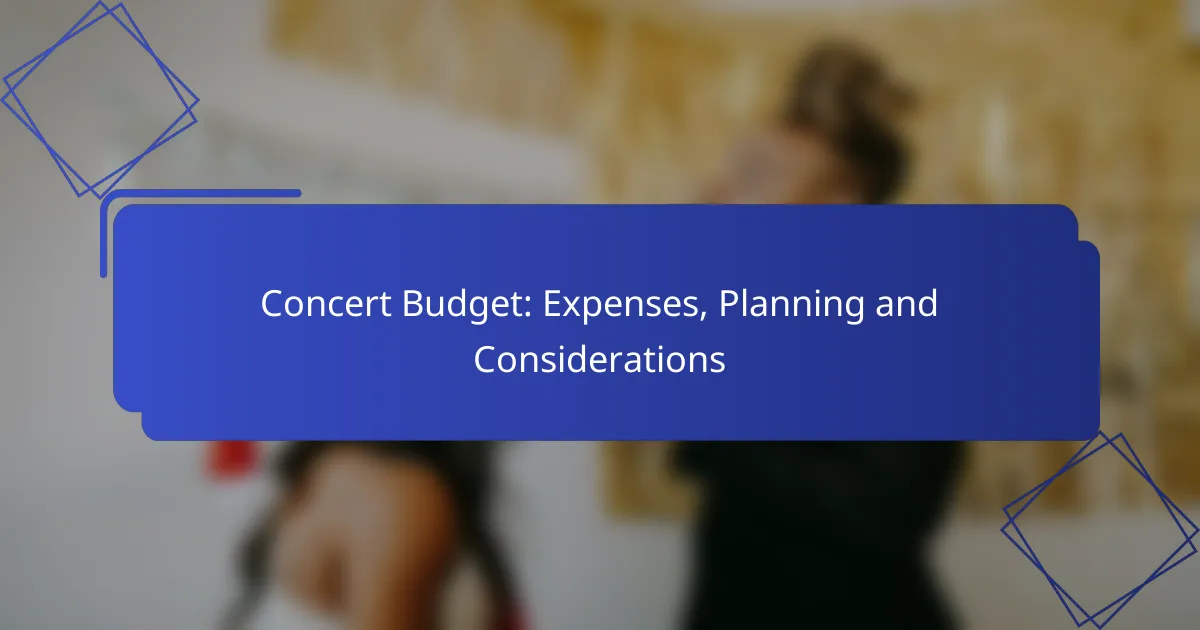Planning a concert requires a detailed budget that encompasses key expenses such as venue rental, artist fees, and production costs. By identifying necessary expenses and setting financial limits, organizers can effectively manage their resources and avoid overspending. Additionally, careful consideration of factors like audience demographics and event timing is crucial for ensuring a successful experience.

What are the key expenses for a concert budget?
The key expenses for a concert budget include venue rental, artist fees, production and equipment costs, marketing and promotion, as well as staffing and security. Understanding these elements helps in effectively planning and managing the overall budget for a successful event.
Venue rental costs
Venue rental costs are often one of the largest expenses in a concert budget. Prices can vary significantly based on location, size, and amenities, typically ranging from hundreds to thousands of dollars. Consider factors like accessibility, capacity, and acoustics when selecting a venue.
When budgeting for venue costs, account for additional fees such as insurance, deposits, and utilities. It’s wise to compare multiple venues to find the best fit for your budget and event requirements.
Artist fees
Artist fees can vary widely depending on the popularity and experience of the performer. Emerging artists might charge a few hundred dollars, while well-known acts can demand tens of thousands or more. Negotiating fees and understanding the artist’s requirements is crucial for budget management.
In addition to the base fee, consider expenses like travel, accommodations, and hospitality for the artists. These can add significantly to the overall cost, so it’s essential to factor them into your budget from the outset.
Production and equipment expenses
Production and equipment expenses encompass sound, lighting, and staging needs. Depending on the scale of the concert, these costs can range from a few thousand to several tens of thousands of dollars. It’s important to hire experienced professionals to ensure quality and safety.
When planning for production costs, create a detailed list of required equipment and services. This should include sound systems, lighting rigs, and any special effects. Always allocate a portion of your budget for unexpected technical needs that may arise during the event.
Marketing and promotion costs
Marketing and promotion costs are essential for attracting an audience to your concert. These expenses can include advertising, social media campaigns, and promotional materials, typically ranging from hundreds to several thousand dollars. Effective marketing strategies can significantly impact ticket sales.
Consider using a mix of digital and traditional marketing methods to reach a broader audience. Allocate funds for targeted ads and collaborations with local influencers to maximize your promotional efforts.
Staffing and security expenses
Staffing and security expenses are critical for ensuring the smooth operation of the concert. This includes hiring event staff, security personnel, and volunteers, with costs varying based on the size of the event and local wage standards. Plan for both front-of-house and backstage staff to manage different areas effectively.
When budgeting for staffing, consider the need for trained security to handle crowd control and emergencies. It’s advisable to consult with local regulations regarding security requirements for public events to ensure compliance and safety.

How to effectively plan a concert budget?
Effectively planning a concert budget involves setting financial limits, identifying necessary expenses, and utilizing tools to track costs. A well-structured budget helps ensure that all essential elements are covered while avoiding overspending.
Set a clear budget limit
Establishing a clear budget limit is crucial for successful concert planning. Determine the total amount you can allocate, considering ticket sales, sponsorships, and personal funds. A common range for small to medium concerts might be anywhere from a few thousand to tens of thousands of dollars, depending on the venue and scale.
Once you have a budget limit, break it down into categories such as venue, equipment, marketing, and staffing. This will help you visualize where your money is going and make adjustments as needed.
Prioritize essential expenses
Identifying and prioritizing essential expenses is key to staying within your budget. Focus on costs that directly impact the concert experience, such as venue rental, sound equipment, and artist fees. These are typically non-negotiable and should be funded first.
Consider creating a tiered list of expenses, categorizing them into ‘must-haves’ and ‘nice-to-haves.’ For example, while hiring a professional sound engineer may be essential, hiring a high-profile opening act might be less critical if funds are tight.
Use budgeting tools like Eventbrite
Utilizing budgeting tools like Eventbrite can streamline your concert planning process. These platforms offer features for tracking expenses, ticket sales, and overall financial performance, making it easier to manage your budget in real-time.
Additionally, many budgeting tools provide templates and resources that can help you outline your costs and revenue projections. This can be particularly useful for first-time concert planners who may not be familiar with all potential expenses.

What considerations should be made for concert planning?
Concert planning requires careful consideration of various factors to ensure a successful event. Key aspects include understanding the audience, selecting an accessible location, and timing the event appropriately.
Audience capacity and demographics
Determining audience capacity and demographics is crucial for concert planning. This involves assessing the venue’s size and the target audience’s age, preferences, and cultural background. For example, a venue that holds 1,000 people may be suitable for a local band, while a larger arena may be necessary for a well-known artist.
Understanding demographics helps tailor marketing strategies and ticket pricing. For instance, if targeting younger audiences, consider using social media promotions and lower ticket prices to attract attendees.
Location accessibility
Location accessibility plays a significant role in concert attendance. Ensure the venue is easily reachable by public transport and has adequate parking facilities. Consider the surrounding area for safety and convenience, as well as the availability of accommodations for out-of-town guests.
Additionally, check for compliance with local regulations regarding accessibility for individuals with disabilities. This may include wheelchair access, designated seating, and accessible restrooms, which can enhance the overall experience for all attendees.
Timing and scheduling
Timing and scheduling are vital for maximizing attendance and ensuring a smooth event. Choose a date that avoids major holidays or local events that could compete for audience attention. Weekends or evenings are typically more favorable for concerts, as people are more likely to be available.
Consider the timing of ticket sales and promotions as well. Launching ticket sales several months in advance can create buzz and allow for better planning. Additionally, scheduling the concert during a season when the weather is likely to be pleasant can enhance the experience for outdoor events.

What are common pitfalls in concert budgeting?
Common pitfalls in concert budgeting include underestimating costs, ignoring contingency funds, and neglecting marketing expenses. These mistakes can lead to financial shortfalls and impact the overall success of the event.
Underestimating costs
Underestimating costs is a frequent issue in concert budgeting that can derail financial plans. Many promoters overlook essential expenses such as venue fees, equipment rentals, and staffing, which can add up quickly. It’s crucial to create a detailed budget that accounts for all potential costs, including those that may not be immediately obvious.
A practical approach is to research typical costs in your area and include a buffer of around 10-20% for unexpected expenses. This way, you can avoid surprises that could jeopardize the concert’s profitability.
Ignoring contingency funds
Ignoring contingency funds can leave you unprepared for unforeseen circumstances. A contingency fund acts as a financial safety net, covering unexpected costs like equipment failure or last-minute changes in venue. Without this buffer, you risk facing financial strain that could affect the concert’s execution.
As a rule of thumb, set aside at least 5-10% of your total budget for contingencies. This practice ensures that you can handle surprises without derailing your overall financial plan.
Neglecting marketing expenses
Neglecting marketing expenses can significantly limit ticket sales and audience engagement. Effective marketing is essential for promoting the concert and attracting attendees. Many organizers underestimate the costs associated with advertising, social media campaigns, and promotional materials.
To avoid this pitfall, allocate a specific percentage of your budget—typically around 15-20%—to marketing efforts. This investment can yield substantial returns by increasing visibility and driving ticket sales, ultimately enhancing the concert’s success.

How to evaluate the success of a concert budget?
Evaluating the success of a concert budget involves analyzing whether the actual expenses and revenues align with the projected figures. Key metrics include profit margins, attendance rates, and overall audience satisfaction.
Key performance indicators (KPIs)
Key performance indicators (KPIs) are essential for measuring the success of a concert budget. Common KPIs include total revenue, total expenses, ticket sales, and merchandise sales. Tracking these metrics helps identify areas for improvement and ensures financial goals are met.
Comparing projected vs. actual expenses
Comparing projected expenses to actual costs is crucial for assessing budget success. This involves reviewing each line item, such as venue rental, artist fees, and marketing costs. Discrepancies can highlight overspending or areas where savings were achieved.
Audience feedback and satisfaction
Audience feedback is a vital component of evaluating concert success. Surveys and social media engagement can provide insights into attendee satisfaction, which can influence future budgeting decisions. High satisfaction rates often correlate with repeat attendance and positive word-of-mouth, impacting long-term financial success.
Post-concert financial analysis
Conducting a post-concert financial analysis helps in understanding the overall financial health of the event. This includes reviewing profit margins and return on investment (ROI). A thorough analysis can guide future budgeting strategies and improve financial planning for subsequent concerts.



